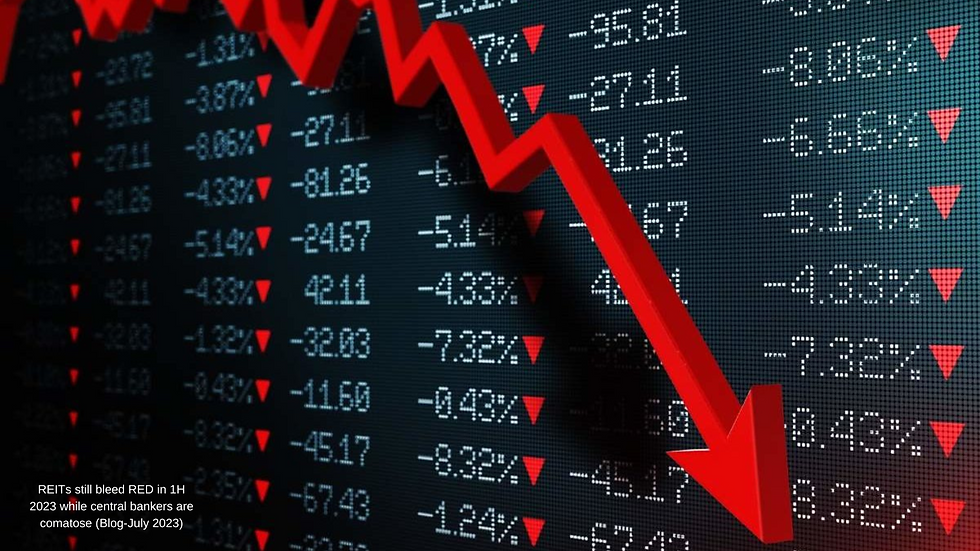PROFITING FROM HIGH DIVIDEND STOCKS
- by Gabriel Yap

- Nov 18, 2017
- 3 min read
02/2013-
Whilst 2012 ended with modest gains for some investors, those who adopted a High Dividend Stock Investing strategy (HDS) would have outperformed the markets sharply – real estate investment trusts, or REITS, climbed 33% compared to the FTSTI climb of 16.5%. A portfolio of high dividend stocks, per Table 1 below, would have climbed 21%, again outperforming the FTSTI by a clear 5%

One perceptible investment trend among institutional investors in 2012 was to seek emerging market stocks which pay high dividends. This would have been a middle ground sought between what would traditionally been considered exposure to pure growth plays with a desire for steady income coupled with lower volatility – hallmarks that investors look for post-2008 Global Financial Crisis.
In fact, there have been at least 50 new funds launched in 2012 which ride on the above investment style which I foresee, will become even more entrenched this year. For me, investing in HDS kills two birds with one stone – it allows the investor to ride on the compounding of growth and income while reducing the risks as most of the HDS are in traditionally steady businesses, short of what business analysts would have termed as "cash-cow" businesses, but definitely in what I would term as the "cow-milking" stage of the business as most of the HDS would be generating free cashflows way above the normal business needs of capital expenditure, expansion plans and maintenance allowances to pay investors a steady and decent dividend.
Within the emerging market portfolio, especially Asia, there are already close to 300 stocks that pay dividends yields of more than 4%, almost twice the average dividend yield of 2.5% available on Wall Street's S&P500. I would surmise that more emerging market stocks would join that rank this year and that 4% level would head north even more as most companies are likely to enlarge their dividend payout ratios as underlying profitability increases.
In fact, 2013 started with a bang for me as the Shanghai Stock Exchange (SSE), in a 7th Jan 2013 statement, urged all shanghai-listed companies to disclose their dividend policies and deliver a certain portion of their net profits as dividends to shareholders. The SSE recommended that on an average, listed companies should distribute 30% of its net earnings as dividends. A 50% payout would be considered a high standard in the same vein.
To me, the SSE statement signals a strong possibility of the Chinese stock market finally turning around this year, bolstered by stronger GDP growth, low inflation and low valuations. Higher dividend payouts are seen as part of stronger corporate governance policies as management are perceived as willing to share with investors, the underlying profitability growth of the business.
In fact, the SSE statement goes as far as to enunciate that if investors are not satisfied with the dividend payout ratio of any A-share firm, they can file a complaint with the SSE. Alternatively, if a listed A-share firm thinks a higher dividend payment may be unfair to investors, they can also submit a written report to SSE to explain its position.
In case of a special situation that renders a company unable to pay a dividend, it should be required to give a detailed explanation in its annual report. Also, the dividend payout ratio would need a two-thirds support at its annual general meeting.
In a longer term plan, the SSE will create some indices on dividend payout ratios in conjunction with public satisfaction. Such indices would then be used by the SSE to determine whether an A-share firm can enjoy faster approval of future refinancing or merger and acquisitions applications. The guidelines are in line with a directive from China Securities Regulatory Commission for the stock markets to attract more professional and long term investors and partly to help address the 3-year consecutive decline in the Shanghai stock market.
Together with a sliding scale for tax on dividends, which also came into effect in the first week of Jan 2013, I believe that these steps, if implemented successfully, will be a "game changer" for the Chinese stock market in the current year and its wide ranging effects to be felt even more in the coming years.
Coming back to Singapore, it is clear that "boring companies" like Singtel, M1, Starhub and SPH are actually "cow-milking" companies. They generate operating cashflows above their capital expenditure and working capital requirements. The excess cashflows, are a good source of steady dividend payouts to shareholders. Coupled with their "not expensive" valuation tag, they should form the backbone of a HDS investment strategy, which I believe, will gain further grounds in the coming years.




Comments